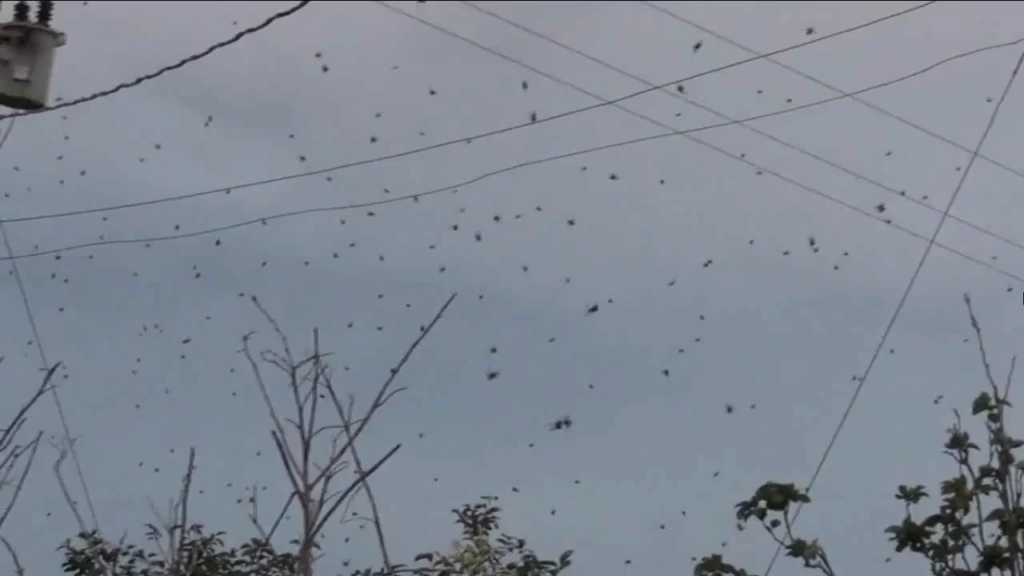Creatures rain down from the sky in Brazil, creating an eerie and unsettling spectacle that has left many people astounded. In a small town called Sao Thome das Letras, residents and visitors witnessed hundreds of spiders appearing to fall from the sky, covering the air with their delicate, nearly invisible webs.
This rare and bizarre phenomenon was captured on video and quickly went viral on social media, sparking widespread curiosity and intrigue.
While the sight of hundreds of eight-legged creatures suspended in mid-air may seem like a scene from a horror movie, experts have assured that this is a natural event that occurs annually in certain regions of Brazil.
The Science Behind the Mysterious Spider Rain
Despite the fear and confusion the video caused among viewers, scientists have explained that the spider rain in Brazil is a well-documented natural occurrence.
The phenomenon happens in hot and humid rural areas, particularly between December and March. During this time, a specific species of social spiders known as Parawixia bistriata engages in a unique and fascinating survival strategy that results in the illusion of spiders raining from the sky.
Biologist Kayron Passos, who specializes in arachnology, clarified that these spiders create massive webs that span vast distances between trees and other structures. These communal webs, often measuring several meters across, are nearly invisible to the naked eye, giving the impression that the spiders are floating in the sky.
Read : Flesh-Eating Disease Develops in 59-Year-Old Man After Being Bitten by Spider in the UK
The spiders use these extensive networks to catch flying insects and facilitate their mating rituals. Unlike many solitary spider species, Parawixia bistriata thrives in large colonies, coordinating their web-building efforts to maximize efficiency.
😳 Spiders have taken over the sky in Brazil. This apocalypse happens every year from December to March in hot and humid weather in rural areas.
— Gennady Simanovsky (@GennadySimanovs) February 1, 2025
Huge groups of up to 500 spiders weave webs that stretch across the entire sky.
No danger to humans. pic.twitter.com/xAjEtUgnnR
Mr. Passos further explained that the reason the spiders appear to be falling is due to a synchronized mating ritual. As male spiders seek out females, they move around the web in large numbers, creating a visually striking scene when viewed from below.
Once mating is complete, the spiders often detach from their silk threads, giving the illusion that they are dropping from the sky. However, these creatures are not actually falling but rather relocating within their web structures.
The Role of Climate and Environment in Spider Rain
Brazil’s warm and humid climate plays a crucial role in facilitating this strange occurrence. The spiders rely on specific weather conditions to construct their vast web networks and sustain their colonies. During the rainy season, when there is an abundance of food, these spiders reproduce rapidly, leading to large gatherings in the sky.
Another contributing factor is the relatively undisturbed rural landscapes where these events take place. Unlike urban environments where buildings and human activity disrupt spider habitats, the open fields and forests of Sao Thome das Letras provide an ideal setting for Parawixia bistriata to construct their intricate web structures.
These massive spider colonies work together to capture flying insects such as mosquitoes, playing a vital role in controlling local insect populations.

Experts have also pointed out that the presence of these spiders should not be a cause for alarm. Despite their intimidating appearance in large numbers, Parawixia bistriata is harmless to humans.
They do not possess venom potent enough to pose a threat, and they prefer to stay within their webs rather than actively seek out human contact. In fact, their presence helps maintain ecological balance by keeping insect populations in check.
Cultural Reactions and Viral Sensation
The viral video of spiders appearing to rain from the sky has sparked a range of reactions from people around the world. While some viewers expressed fascination and amazement at the natural phenomenon, others found the sight deeply unsettling.
Many social media users compared the scene to a biblical plague or an apocalyptic event, fueling speculation and exaggerated theories about the occurrence.
One social media user wrote, “Spiders have taken over the sky in Brazil. This apocalypse happens every year from December to March in hot and humid weather in rural areas. Huge groups of up to 500 spiders weave webs that stretch across the entire sky. There is no danger to humans.”

Despite the initial fear and disbelief, scientific explanations have helped reassure the public that there is nothing supernatural or dangerous about this event. Videos and images of spider rain have been documented in Brazil for years, and experts continue to study the behavior of these social spiders to better understand their ecological significance.
For the residents of Sao Thome das Letras, this annual spectacle has become a familiar sight. While some embrace it as a marvel of nature, others prefer to stay indoors until the event passes.
Regardless of personal reactions, the phenomenon of spider rain remains one of the most fascinating examples of nature’s wonders, showcasing the complexity and adaptability of the animal kingdom.
The sight of hundreds of spiders appearing to fall from the sky may seem terrifying at first, but it is a remarkable display of nature’s intricacies.
As scientists continue to study these creatures and their behaviors, such events remind us of the fascinating and sometimes mysterious ways in which different species interact with their environment. The next time spiders rain down from the sky in Brazil, it will serve as yet another reminder of the endless wonders our planet has to offer.
let’s enjoy few years on earth with peace and happiness….✍🏼🙏

